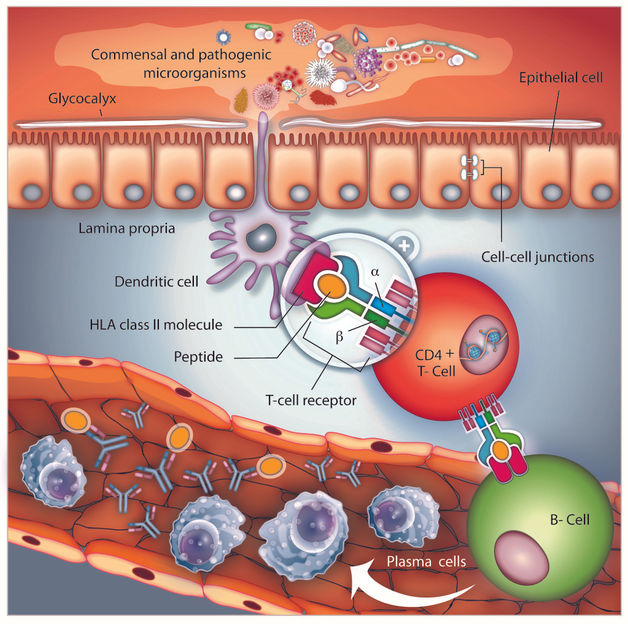Immune responses in chronic inflammatory bowel diseases
New population of immune cells that is highly abundant in Crohn’s disease patients
Advertisement
Chronic inflammatory bowel diseases (IBDs) like Crohn's disease and ulcerative colitis are characterized by inflammation of the gastrointestinal tract which flares up in phases and which is accompanied by abdominal pain, diarrhea and severe impairment of the quality of life. The inflammation is triggered by an excessive response of the immune system. It is driven in particular by T lymphocytes (also called T cells). Using their T cell receptor (TCR), they can recognize antigens (e.g. foreign proteins) and trigger an immune response that exactly matches a specific antigen. These specialized immune cells are the focus of research by a team from the Cluster of Excellence “Precision Medicine in Chronic Inflammation” (PMI). “The aim of our study was to identify specific T lymphocytes associated with these diseases," explained Dr. Elisa Rosati, former postdoctoral researcher at the Institute of Clinical Molecular Biology (IKMB) at Kiel University (CAU) and the University Medical Center Schleswig-Holstein (UKSH), Campus Kiel. The idea was to investigate T cells involved in disease onset and progression in order to better understand the immune mechanisms of these diseases and thereby identify new diagnostic markers or targets for future treatments. In this study, the team found what they were looking for: “We were able to identify a new, subgroup of T cells that is highly abundant in Crohn’s disease patients,” said Rosati, who now works at Evotec SE in Hamburg. The results of the study have been published in the scientific and clinical journal Gut.

Immune responses on intestinal mucosal barriers play a key role in chronic inflammatory bowel diseases. Depicted here is the interaction between T lymphocytes with human leukocyte antigen (HLA) complex and the antigen-presenting cell
© Andre Franke/Renate Nikolaus, Kiel University
A new subgroup of T cells was discovered
Specific T cells can be characterized by analyzing their T cell receptors (TCRs). These receptors are found on the surface of the cells and distinguish different T cells depending on which antigen they recognize. “They therefore work as a sort of identity card for each T cell,” explained Professor Petra Bacher, co-leader of the study. “Using a special sequencing technique, we analyzed hundreds of thousands of T cell receptors from the blood and the intestinal tissue of patients with chronic inflammatory bowel diseases and healthy individuals.” In addition, the most innovative single cell sequencing techniques were employed to characterize specific T lymphocytes and study their functional properties. It became apparent that a certain group of T cell receptors is highly abundant in the blood of Crohn's disease patients. Although these cells are also present in healthy people, they are strongly increased in Crohn’s disease patients. Rosati said “We know that Crohn’s disease is a very heterogeneous disease that is very different from person to person. The presence or absence of these cells, that we have named Crohn-associated invariant T cells (CAIT), could potentially delineate a new immunological subtype of the disease.”
A possible target for diagnostic “profiling”
CAIT cells could also help to distinguish between Crohn’s disease and ulcerative colitis, the two main forms of chronic inflammatory bowel diseases. From a clinical perspective, these are two independent diseases with different disease phenotypes. However, although the two diseases have different clinical features and markers, these are not always clear, which sometimes results in misdiagnoses. “Further findings on the differences between the two forms of IBD could lead to a better understanding of their pathophysiology as well as the development of future strategies for diagnosis and treatment of the diseases,” explained senior author Professor Andre Franke, Director of the IKMB.
The functional profile of individual T cells in some blood and bowel samples was studied in greater detail. This revealed that CAIT cells belong to a special group of T lymphocytes which are functionally in between adaptive and innate immunity. These innate-like T cells most often do not recognize pathogens through the classical human leukocyte antigen (HLA) presenting molecules but recognize other molecules, and are thus defined as "unconventional T cells". One type of unconventional T cells are natural killer T cells. The T cell population identified here has very similar characteristics to natural killer cells, which are part of the innate immune system. “The CAIT cells identified by us seem to be a subgroup of natural killer T cells. The role of these cells in IBDs and, in particular, in Crohn's disease is still unclear and our findings suggest it could be interesting to investigate this further,” stressed Andre Franke.
Which antigen the CAIT cells recognize, i.e., what triggers the immune response, could not yet be clarified. This question is the focus of ongoing studies.

























































